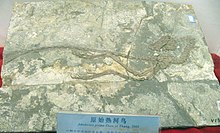Jeholornis
|
Jeholornis Temporal range: Early Cretaceous, 122–120 Ma |
|
|---|---|
 |
|
| Fossil specimen of a juvenile J. prima (IVPP V13550) | |
| Scientific classification | |
| Kingdom: | Animalia |
| Phylum: | Chordata |
| Class: | Reptilia |
| Clade: | Dinosauria |
| Order: | Saurischia |
| Suborder: | Theropoda |
| Clade: | Avialae |
| Genus: |
†Jeholornis Zhou & Zhang, 2002 |
| Type species | |
|
†Jeholornis prima Zhou & Zhang, 2002 |
|
| Other Species | |
|
†J. palmapenis O'Connor et al., 2012 †J. curvipes Lefèvre et al., 2014 |
|
| Synonyms | |
|
Shenzhouraptor Ji et al., 2002 |
|
†J. palmapenis O'Connor et al., 2012
†J. curvipes Lefèvre et al., 2014
Shenzhouraptor Ji et al., 2002
Jeholornis (meaning "Jehol bird") is a genus of avialans that lived between approximately 122 and 120 million years ago during the early Cretaceous Period in China. Fossil Jeholornis were first discovered in the Jiufotang Formation in Hebei Province, China (in what was previously Rehe Province, also known as Jehol—hence the name) and additional specimens have been found in the older Yixian Formation.
Jeholornis had long tails and few small teeth, and were approximately the size of turkeys, making them among the largest avialans known until the Late Cretaceous. Their diet included seeds of cycads, Ginkgo or similar plants.
Jeholornis were relatively large, primitive avialans, with a maximum adult length of up to 80 cm (2.6 ft). Their skulls were short and high, similar to other primitive avialans like Epidexipteryx and to early oviraptorosaurs like Incisivosaurus. The lower jaws were short, stout, and curved downward, possibly an adaptation for eating seeds.Jeholornis prima lacked teeth in their upper jaws, and had only three small teeth in their lower jaws, while J. palmapenis had a few teeth in the middle of the upper jaw (maxilla) but none in the front (premaxilla). The upper teeth of J. palmapenis seem to have been angled slightly forward as in some other basal avialans. The teeth in all three species were small, blunt and peg-like with no serrations.
...
Wikipedia
